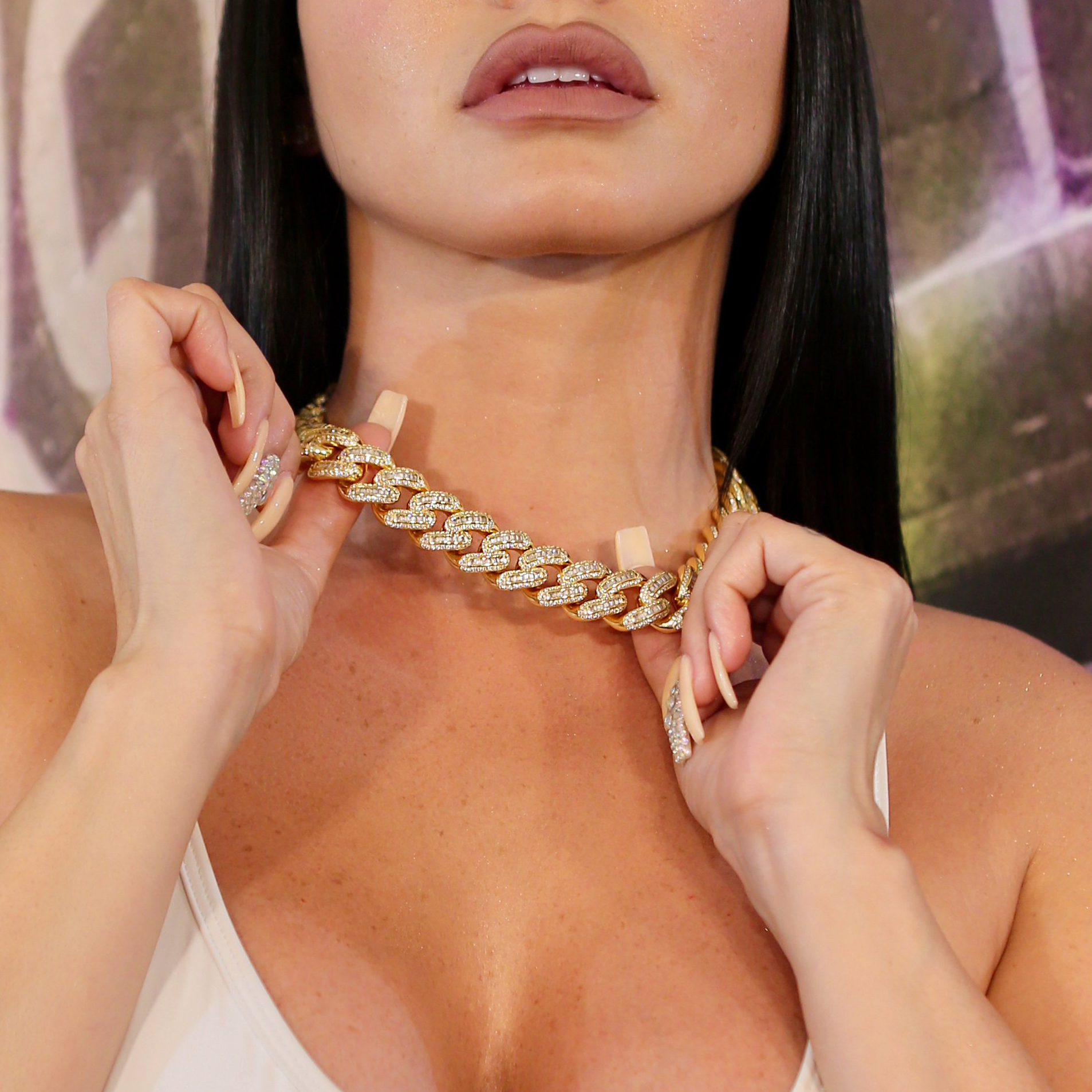To describe something as 24-karat gold means it is the best of the best—the most premium top-quality. But when it comes to jewelry, is 24K gold actually the best choice? This article will touch on why even though 24K is pure, 18K is actually better for wearable jewelry.
What Is 24K Gold?
24K gold is 99.9% pure gold—the highest purity you can get. It contains virtually no other metals, making it the softest and most malleable form of gold available.
The Composition
- Gold content: 99.9% pure gold
- Alloy metals: 0.1% (trace amounts only)
- Color: Deep, rich yellow—the purest gold tone
The Problem with 24K Gold for Jewelry
While 24K sounds impressive, it's actually impractical for jewelry you want to wear. Here's why:
1. Too Soft for Daily Wear
Pure gold is extremely soft and malleable. This means:
- Scratches easily: Even light contact can leave marks
- Bends and deforms: Chains can kink, links can stretch, rings can lose their shape
- Prongs fail: Can't hold stones securely—prongs bend and stones fall out
- Clasps break: Too weak to withstand daily opening and closing
2. Not Suitable for Intricate Designs
24K gold can't hold the crisp details needed for:
- Cuban link chains (links would deform)
- Tennis chains (prongs would bend, stones would fall out)
- Rope chains (twisted design would lose shape)
- Pendants with fine details (edges would wear down)
3. Impractical for Everyday Life
If you actually wear your jewelry, 24K won't survive:
- Typing on a keyboard can scratch it
- Putting on a jacket can snag and bend it
- Normal movement causes wear and deformation
- You'd need to baby it constantly—not practical for real life
4. Can't Create White or Rose Gold
24K is pure yellow gold only. You can't create:
- White gold finishes (requires alloy metals)
- Rose gold tones (requires copper alloys)
- Color variations that modern jewelry demands
When Is 24K Gold Actually Used?
24K gold has its place—just not in wearable jewelry:
- Investment bars and coins: Where purity matters more than durability
- Cultural/ceremonial pieces: Worn rarely, not daily
- Display jewelry: Meant to be looked at, not worn
- Gold leaf: Decorative applications where softness is an advantage
Why 18K Gold Is Better Than 24K for Jewelry
1. The Perfect Balance
18K gold (75% gold, 25% alloy metals) gives you:
- Rich color: Deep, luxurious gold tone—nearly as rich as 24K
- Practical durability: Hard enough for daily wear without being brittle
- Real gold content: Three-quarters actual gold—still premium and valuable
- Workability: Can be crafted into intricate designs that hold their shape
2. Superior for Stone Settings
18K's balanced hardness means:
- Prongs grip securely: Holds CZ, moissanite, and diamonds without bending
- Settings stay tight: Stones don't fall out with normal wear
- Perfect for tennis chains: Continuous stone settings that last
- Iced pieces stay iced: Premium CZ stones remain secure
3. Enables Premium Finishes
18K allows for stunning variations 24K can't achieve:
- White gold: Crisp, modern, frosty—pairs with steel watches and streetwear
- Yellow gold: Rich warmth with practical durability
- Rose gold: Soft, romantic tone that's impossible with pure gold
4. Holds Shape and Detail
18K maintains crisp designs that 24K can't:
- Cuban links: Bold texture that stays defined
- Rope chains: Twisted design that holds its spiral
- Pendants: Fine details that don't wear down
- Clasps: Secure mechanisms that actually work
5. Better Value for Wearable Jewelry
With 18K you get:
- Jewelry you can actually wear: Not just display pieces
- Long-lasting quality: Doesn't deform or scratch easily
- Professional standard: What luxury jewelers worldwide use
- Strong resale value: High gold content that holds worth
24K vs 18K: The Real Comparison
Purity
- 24K: 99.9% pure gold
- 18K: 75% gold
- Winner for jewelry: 18K—purity doesn't matter if you can't wear it
Color
- 24K: Deep, rich yellow—the purest gold tone
- 18K: Rich, warm yellow—nearly as luxurious, plus white and rose options
- Winner: 18K—versatility and nearly identical richness
Durability
- 24K: Too soft—scratches, bends, deforms easily
- 18K: Perfect balance—durable enough for daily wear, soft enough for intricate work
- Winner: 18K—no contest for wearable jewelry
Stone Security
- 24K: Prongs bend, stones fall out—unusable for set jewelry
- 18K: Grips stones securely—ideal for tennis chains and iced pieces
- Winner: 18K—24K can't even compete here
Design Capability
- 24K: Can't hold intricate details or crisp edges
- 18K: Perfect for Cuban links, rope chains, pendants, and complex designs
- Winner: 18K—enables the jewelry you actually want
Practical Wearability
- 24K: Display only—too delicate for real life
- 18K: Built for daily rotation—survives normal wear
- Winner: 18K—jewelry should be worn, not stored
Why BLNG Uses Heavy 18K Plating (Not 24K)
At BLNG, we could use 24K plating—but we don't. Here's why 18K is the smarter choice:
Practical Durability
Our heavy 18K plating (up to 10x thicker than typical boutique pieces) delivers long-lasting color and shine that survives daily wear. 24K plating would scratch off immediately.
Rich Color That Lasts
18K gives you that deep, warm gold tone that photographs beautifully—nearly identical to 24K richness, but with the durability to keep that color season after season.
Perfect for Stone Settings
Our tennis chains and iced Cubans need plating that holds prongs securely. 18K does this perfectly; 24K would fail.
Enables All Finishes
18K plating allows us to offer white gold, yellow gold, and rose gold options. 24K would limit us to yellow only.
Professional Standard
High-end jewelers worldwide use 18K for plating because it's the quality standard. We follow that same professional approach.
The Honest Truth About 24K Gold
24K gold is pure—and that's its only advantage. For investment bars and coins, purity matters. For jewelry you actually want to wear, 24K is impractical:
- Too soft to survive daily life
- Can't hold stones securely
- Deforms and scratches easily
- Can't create white or rose gold finishes
- Not suitable for intricate designs
- Requires constant babying
18K gold gives you 75% pure gold—still premium and valuable—with the practical durability to actually wear and enjoy your jewelry.
How to Style 18K Gold Jewelry
White Gold (18K)
Crisp, modern, frosty—pairs with steel watches, streetwear, and minimalist fits.
- 3mm Tennis Chain (White Gold)
- 4mm Tennis Chain (White Gold)
- 12mm Iced Out Cuban Link Chain (White Gold)
Yellow Gold (18K)
Rich, warm, classic—the "gold" everyone recognizes, with practical durability.
Rose Gold (18K)
Soft, romantic, quietly luxe—impossible with 24K purity.
Width & Length Guide
- Widths: 3–4mm for clean daily looks; 12mm for bold statements
- Lengths: 50 cm (20") is the universal sweet spot; 55 cm (22") adds drop; 60 cm (24") sits relaxed over hoodies
Care for 18K-Plated Jewelry
- Wipe with a soft cloth after wear
- Apply fragrance before jewelry, not after
- Avoid pools, hot tubs, and harsh chemicals
- Store separately to prevent micro-scratches
- Quick clean: lukewarm water + mild soap → rinse → dry fully
Shop BLNG's Heavy 18K Plated Collection
- Tennis Chains — Clean sparkle with 18K richness
- Cuban Link Chains — Bold texture in premium 18K finish
- Cuban Link Bracelets — Wrist symmetry with 18K glow
- Pendants — Meaningful symbols in 18K finishes
The Bottom Line: 24K vs 18K
24K gold is the purest—but purity doesn't equal quality for wearable jewelry. It's too soft, can't hold stones, deforms easily, and limits your finish options. It's great for investment bars, but terrible for chains, bracelets, and pendants you actually want to wear.
18K gold is the smart choice: 75% pure gold for real value and prestige, balanced with 25% alloy metals for practical durability. It holds intricate designs, grips stones securely, enables white and rose gold finishes, and survives daily wear—all while delivering that rich, luxurious gold tone.
At BLNG, we use heavy 18K plating (up to 10x thicker than typical pieces) because it's the professional standard. You get the premium look and feel of high-karat gold with the durability to actually wear and enjoy your jewelry.
If you want jewelry that looks expensive and lasts, 18K is the only choice that makes sense.






Share:
What is 14K Gold? Is 14K Gold Good Quality?
What Does the Hamsa Symbol Mean?